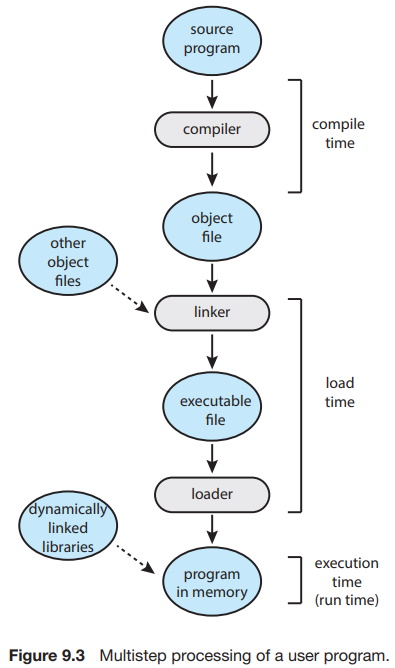Usually, a program resides on a disk as a binary executable file. To run, the program must be brought into memory and placed within the context of a process, where it becomes eligible for execution on an available CPU. As the process executes, it accesses instructions and data from memory. Eventually, the process terminates, and its memory is reclaimed for use by other processes.
Most systems allow a user process to reside in any part of the physical memory. Thus, although the address space of the computer may start at 00000, the first address of the user process need not be 00000. You will see later how the operating system actually places a process in physical memory.

In most cases, a user program goes through several steps - some of which may be optional - before being executed (Figure 9.3). Addresses may be represented in different ways during these steps. Addresses in the source program are generally symbolic (such as the variable count). A compiler typically binds these symbolic addresses to relocatable addresses (such as "14 bytes from the beginning of this module"). The linker or loader in turn binds the relocatable addresses to absolute addresses (such as 74014). Each binding is a mapping from one address space to another.
Classically, the binding of instructions and data to memory addresses can be done at any step along the way:
• Compile time. If you know at compile time where the process will reside in memory, then absolute code can be generated. For example, if you know that a user process will reside starting at location R, then the generated compiler code will start at that location and extend up from there. If, at some later time, the starting location changes, then it will be necessary to recompile this code.
• Load time. If it is not known at compile time where the process will reside in memory, then the compiler must generate relocatable code. In this case, final binding is delayed until load time. If the starting address changes, we need only reload the user code to incorporate this changed value.
• Execution time. If the process can be moved during its execution from one memory segment to another, then binding must be delayed until run time. Special hardware must be available for this scheme to work. Most operating systems use this method.
To learn more about how process memory bindings can be implemented effectively in a computer system and about appropriate hardware support, see chapter 9 in The tenth edition of Operating System Concepts.
About the Authors
Abraham Silberschatz is the Sidney J. Weinberg Professor of Computer Science at Yale University. Prior to joining Yale, he was the Vice President of the Information Sciences Research Center at Bell Laboratories. Prior to that, he held a chaired professorship in the Department of Computer Sciences at the University of Texas at Austin.
Professor Silberschatz is a Fellow of the Association of Computing Machinery (ACM), a Fellow of Institute of Electrical and Electronic Engineers (IEEE), a Fellow of the American Association for the Advancement of Science (AAAS), and a member of the Connecticut Academy of Science and Engineering.
Greg Gagne is chair of the Computer Science department at Westminster College in Salt Lake City where he has been teaching since 1990. In addition to teaching operating systems, he also teaches computer networks, parallel programming, and software engineering.
The tenth edition of
Operating System Concepts
has been revised to keep it fresh and up-to-date with contemporary examples of how operating
systems function, as well as enhanced interactive elements to improve learning and the student's
experience with the material. It combines instruction on concepts with real-world applications
so that students can understand the practical usage of the content. End-of-chapter problems,
exercises, review questions, and programming exercises help to further reinforce important
concepts. New interactive self-assessment problems are provided throughout the text to help
students monitor their level of understanding and progress. A Linux virtual machine (including
C and Java source code and development tools) allows students to complete programming exercises
that help them engage further with the material.
A reader in the U.S. says, "This is what computer-related books should be like. It is thorough, in depth, information packed, authoritative, and exhaustive. You cannot get this kind of excellent information from the Internet - or many other computer books these days. It's a shame that quality computer books are declining so rapidly in number. I hope they continue to update and publish this book for many years to come.
More Computer Architecture Articles:
• Dynamic Loading of Program Routines and Dynamically linked libraries (DLLs)
• The Fetch, Decode, Execute Cycle
• Factors in Choosing an Oscilloscope
• Logical Versus Physical Memory Addresses
• The Many Processes of Silicon Wafer Manufacturing
• Digital Logic Transfer Characteristics
• Operating System Process Management
• Operating System File Management
• Introduction to the Raspberry Pi
• Load Balancing Multiple CPUs in Symmetric Multiprocessing



